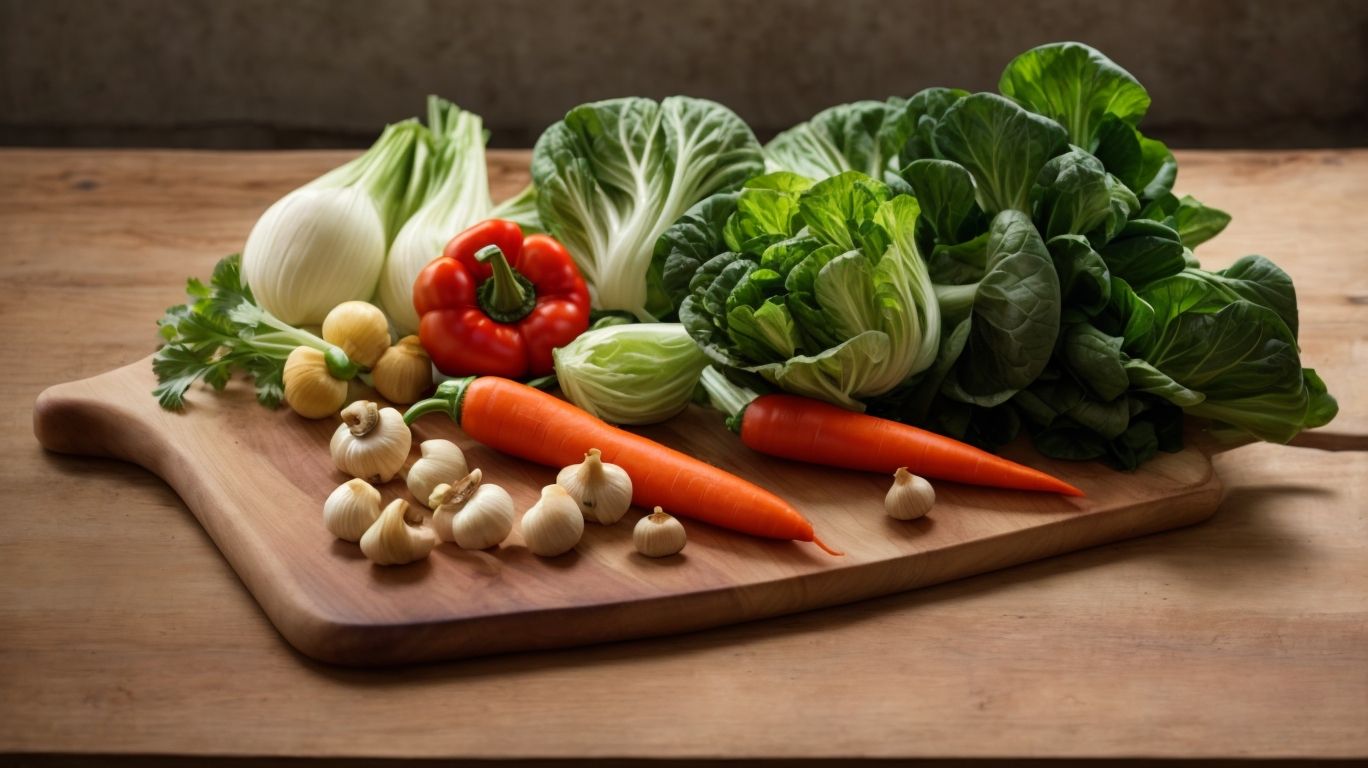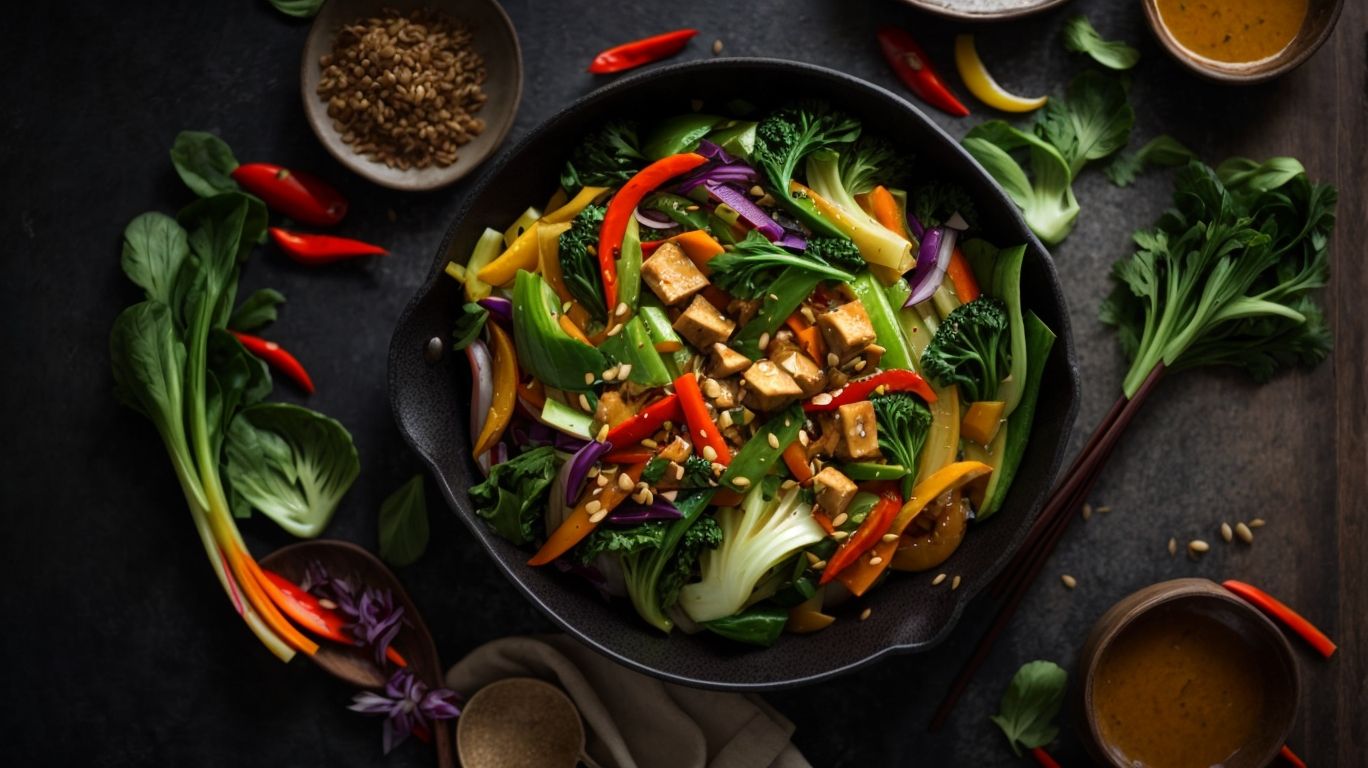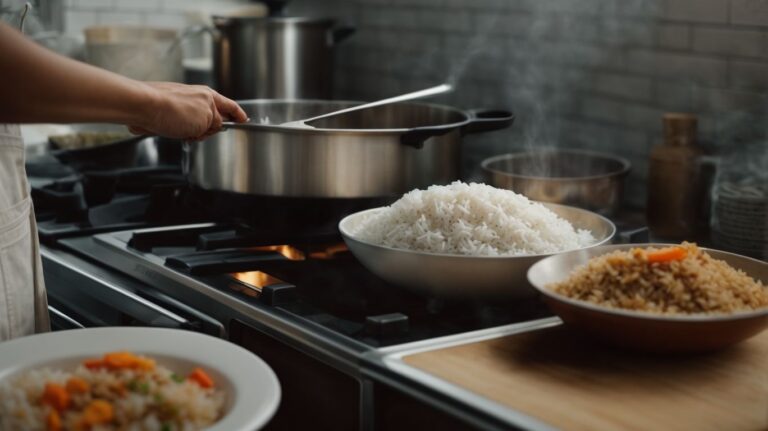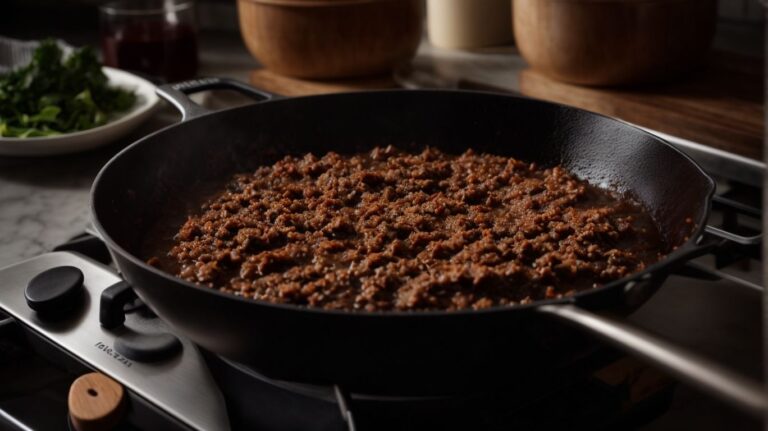How to Cook Bok Choy for Stir Fry?
Welcome to Poormet.com! Today, we are diving into the world of Bok Choy Stir Fry – a delicious and healthy dish that is quick and easy to make.
In this article, we will explore what Bok Choy is, the different types available, the history of stir fry, why Bok Choy is a great choice for this dish, the essential ingredients you’ll need, a step-by-step guide to cooking it perfectly, helpful tips and tricks, and finally, some serving suggestions.
Let’s get cooking!
Key Takeaways:
What is Bok Choy?

Credits: Poormet.Com – Christian Clark
Bok choy, also known as Chinese cabbage, is a leafy vegetable that belongs to the cruciferous family. It is widely used in Chinese cuisine for its crisp texture, mild flavor, and nutritional benefits.
Bok choy is characterized by its dark green leaves and crunchy white stems, which provide a delightful contrast in both texture and taste. This vegetable holds cultural significance in Chinese cooking, often symbolizing prosperity and wealth due to its resemblance to Yuan Bao, ancient Chinese gold and silver ingots. In terms of freshness, bok choy shines, as it is best enjoyed when its leaves are bright green and the stalks are firm. Apart from its fresh appeal, bok choy is also highly nutritious, rich in vitamins A, C, and K, as well as calcium and antioxidants.
Types of Bok Choy
Bok choy comes in various types, with baby bok choy being a popular choice for its tender texture and delicate flavor.
When preparing bok choy, it is essential to pay attention to the sizes, cutting techniques, and cleaning methods to enhance the dish’s overall quality. Baby bok choy is a smaller, more compact version that features crisp stems and dark green leaves. Its mild, slightly sweet taste makes it versatile for stir-fries, soups, or salads. To properly cut baby bok choy, separate the stem from the leaves and slice them into desired shapes. Cleaning involves rinsing under cool water to remove any dirt or debris trapped between the layers.
What is Stir Fry?
Stir fry is a cooking technique that involves quick cooking over high heat in a wok or a pan. It is a popular method in Chinese cuisine known for its ability to retain the natural flavors and textures of the ingredients while creating vibrant and flavorful dishes.
When stir-frying, the heat should be evenly distributed to cook the ingredients quickly while ensuring they remain crispy yet tender. The use of a wok, a versatile pan with high sides and a broad surface area, is ideal for stir-frying due to its ability to conduct heat efficiently. To prevent sticking, it’s essential to use an oil with a high smoking point, such as peanut or vegetable oil. The oil not only adds flavor but also helps create a characteristic sear on the ingredients.
History of Stir Fry
Stir fry has a rich history, originating from Cantonese cuisine and evolving into an iconic cooking style known for its rapid cooking techniques and restaurant-style presentations.
The technique of stir-frying was developed in ancient China, where the bustling Cantonese markets were key in shaping this culinary tradition. Skilled Cantonese chefs honed the art of stir-frying, utilizing high heat and quick movements to create flavorful dishes that retain the natural textures of the ingredients. This approach contrasts with slow-cooking methods prevalent in other cuisines, showcasing the emphasis on freshness and speed in Cantonese culinary practices.
Why Cook Bok Choy for Stir Fry?
Cooking bok choy in a stir fry brings out its delicious flavors and adds a burst of umami to the dish. The unique taste and texture of bok choy complement the vibrant array of ingredients commonly used in stir fry recipes.
Due to its mild yet slightly peppery taste, bok choy provides a refreshing contrast to the savory elements in a stir fry. Bok choy’s crunchy stalks and tender leaves offer a satisfying textural dimension, enhancing the overall mouthfeel of the dish.
When combined with soy sauce, garlic, and ginger, bok choy helps create a harmonious blend of flavors that dance on the palate. This Asian green vegetable also acts as a natural flavor enhancer, intensifying the taste profile of other ingredients in the stir fry.
Ingredients for Bok Choy Stir Fry
Creating a delicious bok choy stir fry requires a blend of fresh ingredients such as garlic, ginger, soy sauce, vinegar, and sesame oil. These components come together to infuse the dish with bold flavors and aromatic profiles that elevate the overall taste.
Garlic serves as the foundation of the flavor profile, offering a savory depth that forms the base of the stir fry.
- Ginger adds a warm and zesty kick, complementing the sweetness of the bok choy.
- Soy sauce imparts a rich umami taste while enhancing the natural flavors of the vegetables.
- Vinegar introduces a tangy note that cuts through the richness, balancing the dish.
- Lime juice provides a refreshing acidity that brightens the overall dish.
- Sesame oil adds a nutty undertone, tying all the flavors together for a harmonious finish.
Vegetables
Incorporating a variety of vegetables like broccoli, mushrooms, edamame, and carrots into your bok choy stir fry adds color, texture, and nutritional value to the dish. These vegetable choices complement the flavors of bok choy and create a well-rounded meal.
Broccoli, known for its vibrant green color and crunchy texture, provides a good source of vitamins C and K, making it a perfect addition to the stir fry. Mushrooms add a savory umami flavor, while their meaty texture complements the tender bok choy leaves.
Edamame, rich in plant-based protein and fiber, brings a delightful nutty flavor to the dish. Carrots not only contribute a pop of orange color but also offer a natural sweetness that balances out the overall taste profile.
Protein
Adding protein sources such as tofu or chicken to your bok choy stir fry enhances its nutritional profile and provides a satisfying meal option. Tofu offers a vegetarian-friendly protein source, while chicken adds a meaty texture and flavor to the dish.
Both tofu and chicken contribute significantly to the overall taste and texture of the stir fry. Tofu, made from soy milk, is a versatile ingredient that absorbs the flavors of the dish while providing a substantial amount of protein.
On the other hand, chicken brings a savory element to the stir fry that complements the fresh, crunchy bok choy. It’s an excellent source of lean protein and adds a satisfying depth of flavor to the ensemble of vegetables.
Sauce and Seasoning
The sauce and seasoning used in a bok choy stir fry play a crucial role in imparting flavor and enhancing the dish’s overall taste. Balancing the flavors with the right amount of water, heat, and seasoning ensures a harmonious blend of tastes in every bite.
In terms of the sauce, it serves as the flavor-packed foundation of the dish, infusing each leaf of bok choy with a delectable essence. The consistency of the sauce is key, as it coats the vegetables to perfection and binds all the elements together. Adjusting the water content can transform the sauce’s texture, from a thick glaze to a light drizzle, offering different mouthfeel experiences.
Seasoning, on the other hand, acts as the final touch, elevating the flavors and bringing depth to the stir fry. The right combination of saltiness, sweetness, and umami creates a symphony of tastes that dance on the palate. The level of heat applied during cooking also plays a significant role; a gentle sauté preserves the freshness of the bok choy while a quick sear can add a delightful charred note.
Step-by-Step Guide to Cooking Bok Choy Stir Fry
Mastering the art of cooking bok choy stir fry involves a systematic approach that covers preparation steps, cooking techniques, and the judicious use of oil. This step-by-step guide ensures a well-executed stir fry with optimal flavors and textures.
Begin by selecting fresh baby bok choy, ensuring it’s firm and vibrant in color.
Wash the bok choy thoroughly under running water and pat dry using paper towels. Remove any wilted leaves and trim off the tough ends.
Julienne the bok choy by cutting it into thin strips, keeping the stems and leaves separated.
Heat a wok or large skillet over medium-high heat and add a high smoke point oil like sesame oil for a flavorful base.
Preparation
The preparation phase for a bok choy stir fry involves cutting, sautéing, and cleaning the ingredients to ensure optimal flavors and textures. Proper preparation sets the foundation for a successful stir fry dish that captures the essence of each component.
In terms of cutting the bok choy, precision is key. Start by separating the stalks from the leaves. The stalks should be cut into thin strips, while the leaves can be roughly chopped. This variety in cutting styles not only adds visual appeal but also ensures a balanced mix of textures in your stir fry.
In terms of sautéing, heat your pan or wok over high heat and add a splash of oil. Once the oil is hot, add the bok choy stalks first, as they require slightly longer cooking time than the leaves. Stir frequently to ensure even cooking and prevent burning.
When cleaning the bok choy, make sure to rinse it thoroughly under cold water. This step is crucial to remove any dirt or impurities that may affect the final taste of your dish. Remember, a little extra effort in preparation goes a long way in elevating the flavors of your bok choy stir fry.
Cooking Process
The cooking process for bok choy stir fry involves precise heat management and culinary finesse reminiscent of Cantonese restaurant-style cooking. Achieving the desired flavors and textures requires attention to detail and skilled execution throughout the cooking process.
Heat control is crucial when stir-frying bok choy, ensuring that the vegetables retain their crispness and vibrant colors, characteristic of Cantonese cuisine. A key technique to master is the ‘Wok Hei’, imparting that wok flavor and smokiness that defines a well-executed stir fry.
By maintaining a high heat and quick cooking time, you can achieve that perfect balance of tenderness and crunch in the bok choy, showcasing the natural sweetness and freshness of the ingredients.
Tips and Tricks for a Perfect Bok Choy Stir Fry

Credits: Poormet.Com – Jeffrey Lewis
Enhance your bok choy stir fry with expert tips and tricks that introduce variations in color, texture, and vibrant flavors. These culinary insights help elevate your dish to restaurant-quality standards and create a visually appealing and delectable meal.
One way to add depth to your bok choy stir fry is by incorporating a mix of colorful vegetables such as bell peppers, carrots, and mushrooms, not only enhancing the visual appeal but also offering a variety of textures and flavors.
You can also experiment with different sauces to elevate the taste profile – try hoisin sauce for a sweet and savory kick or a spicy garlic sauce for a bold flavor infusion.
Serving Suggestions
When serving bok choy stir fry, consider pairing it with steamed rice or noodles for a wholesome meal that can be enjoyed at home. The combination of flavors and textures in this dish offers a balanced taste profile and a nutritious dining experience.
For those looking to elevate their home dining experience, bok choy stir fry is a fantastic choice. The tender-crisp texture of the bok choy paired with the savory flavors of the sauce creates a delightful harmony that appeals to various taste preferences. This dish not only satisfies hunger but also provides an array of essential nutrients, including vitamins A, C, and K, as well as fiber.
Conclusion

Credits: Poormet.Com – Brian Thomas
Preparing bok choy stir fry offers a delightful culinary experience that combines traditional Chinese flavors with modern cooking techniques. The methodical approach to stir frying, coupled with the vibrant taste profiles and careful oil usage, results in a satisfying dish that appeals to both home cooks and food enthusiasts.
When making bok choy stir fry, it’s important to ensure that the bok choy remains crunchy yet tender, providing a textural contrast in each bite. The dish typically features a savory umami flavor from ingredients like soy sauce and garlic, enhancing the overall taste experience. By using a high-heat oil like peanut or sesame oil, the bok choy gets the perfect sear while maintaining its freshness and nutritional value.
Frequently Asked Questions
How to Cook Bok Choy for Stir Fry?
Cooking bok choy for stir fry is a simple and delicious way to incorporate this nutritious vegetable into your meals. Here are some frequently asked questions about how to cook bok choy for stir fry:
1. What is the best way to prepare bok choy for stir fry?
The best way to prepare bok choy for stir fry is to wash it thoroughly and then chop it into bite-sized pieces. This ensures that the bok choy will cook evenly and quickly in the stir fry.
2. Do I need to blanch bok choy before stir frying it?
No, bok choy does not need to be blanched before stir frying. It can be added directly to the hot oil and cooked until tender.
3. Can I use both the leaves and stems of bok choy for stir fry?
Yes, both the leaves and stems of bok choy are edible and can be used in stir fry dishes. Just make sure to chop the stems slightly smaller than the leaves, as they may take longer to cook.
4. How long should I cook bok choy for stir fry?
Bok choy should only take a few minutes to cook in a stir fry. It is best to add it towards the end of the cooking process to prevent it from becoming too wilted.
5. What other ingredients go well with bok choy in a stir fry?
Bok choy pairs well with a variety of proteins and vegetables in a stir fry. Some popular options include tofu, chicken, beef, mushrooms, and bell peppers.
6. Can I add a sauce to my bok choy stir fry?
Yes, you can definitely add a sauce to your bok choy stir fry. A simple combination of soy sauce, garlic, and ginger works well, or you can try a more complex stir fry sauce with different flavors like hoisin or oyster sauce.





